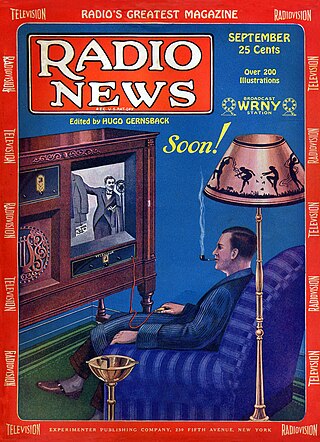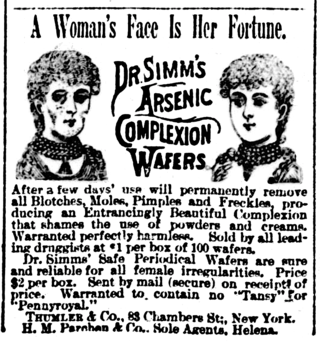Related Research Articles

Advertising is the practice and techniques employed to bring attention to a product or service. Advertising aims to put a product or service in the spotlight in hopes of drawing it attention from consumers. It is typically used to promote a specific good or service, but there are wide range of uses, the most common being the commercial advertisement.

A television advertisement is a span of television programming produced and paid for by an organization. It conveys a message promoting, and aiming to market, a product, service or idea. Advertisers and marketers may refer to television commercials as TVCs.

Sex appeal is often used in advertising to help sell a particular product or service. According to research, sexually appealing content, such as imagery, used for marketing does not need to pertain to the product or service in question. Rather, such content is utilized as an attempt to shape or shift brand image held by the consumer. As more companies have adopted the ad strategy of "sex sells", the prevalence of sexual campaigns has led to controversy. Consumers in society have voiced concern over the techniques and content used for titillating audiences, often stemming from the fact that such ads challenge conventional morals and cultural standards.

Carlill v Carbolic Smoke Ball Company [1892] EWCA Civ 1 is an English contract law decision by the Court of Appeal, which held an advertisement containing certain terms to get a reward constituted a binding unilateral offer that could be accepted by anyone who performed its terms. It is notable for its treatment of contract and of puffery in advertising, for its curious subject matter associated with medical quackery, and how the influential judges developed the law in inventive ways. Carlill is frequently discussed as an introductory contract case, and may often be the first legal case a law student studies in the law of contract.

False advertising is defined as the act of publishing, transmitting, or otherwise publicly circulating an advertisement containing a false claim, or statement, made intentionally to promote the sale of property, goods, or services. A false advertisement can be classified as deceptive if the advertiser deliberately misleads the consumer, rather than making an unintentional mistake. A number of governments use regulations to limit false advertising.

Jean Kilbourne is an American public speaker, writer, filmmaker and activist who is known for her work on the image of women in advertising and her critical studies of alcohol and tobacco advertising. She is also credited with introducing the idea of educating about media literacy as a way to prevent problems she viewed as originating from mass media advertising campaigns. She also lectures about the topic, and her documentaries based on these lectures are viewed around the world.

Banner blindness is a phenomenon in web usability where visitors to a website consciously or unconsciously ignore banner-like information. A broader term covering all forms of advertising is ad blindness, and the mass of banners that people ignore is called banner noise.

The method of loci is a strategy for memory enhancement, which uses visualizations of familiar spatial environments in order to enhance the recall of information. The method of loci is also known as the memory journey, memory palace, journey method, memory spaces, or mind palace technique. This method is a mnemonic device adopted in ancient Roman and Greek rhetorical treatises. Many memory contest champions report using this technique to recall faces, digits, and lists of words.
Shock advertising or shockvertising is a type of advertising that "deliberately, rather than inadvertently, startles and offends its audience by violating norms for social values and personal ideals". It is the employment in advertising or public relations of "graphic imagery and blunt slogans to highlight" a public policy issue, goods, or services. Shock advertising is designed principally to break through the advertising “clutter” to capture attention and create buzz, and also to attract an audience to a certain brand or bring awareness to a certain public service issue, health issue, or cause.
Music in advertising refers to music integrated into mass electronic media advertisements to enhance its success. Music in advertising affects the way viewers perceive the brand by different means and on different levels, and "can significantly affect the emotional response to television commercials." It also affects the musicians whose music is featured in advertisements.
Celebrity branding or celebrity endorsement is a form of advertising campaign or marketing strategy which uses a celebrity's fame or social status to promote a product, brand or service, or to raise awareness about an issue. Marketers use celebrity endorsers in hopes that the positive image of the celebrity endorser will be passed on to the product's or brand's image. Non-profit organizations also use celebrities since a celebrity's frequent mass media coverage reaches a wider audience, thus making celebrities an effective ingredient in fundraising.
The art of memory is any of a number of loosely associated mnemonic principles and techniques used to organize memory impressions, improve recall, and assist in the combination and 'invention' of ideas. An alternative term is "Ars Memorativa" which is also translated as "art of memory" although its more literal meaning is "Memorative Art". It is also referred to as mnemotechnics. It is an 'art' in the Aristotelian sense, which is to say a method or set of prescriptions that adds order and discipline to the pragmatic, natural activities of human beings. It has existed as a recognized group of principles and techniques since at least as early as the middle of the first millennium BCE, and was usually associated with training in rhetoric or logic, but variants of the art were employed in other contexts, particularly the religious and the magical.

Fine print, small print, or mouseprint is less noticeable print smaller than the more obvious larger print it accompanies that advertises or otherwise describes or partially describes a commercial product or service. The larger print that is used in conjunction with fine print by the merchant often has the effect of deceiving the consumer into believing the offer is more advantageous than it really is. This may satisfy a legal technicality which requires full disclosure of all terms or conditions, but does not specify the manner of disclosure. There is strong evidence that suggests the fine print is not read by the majority of consumers.
"Youth Marketing" is a term used in the marketing and advertising industry to describe activities to communicate with young people, typically in the age range of 11 to 35. More specifically, there is teen marketing, targeting people age 11 to 17, college marketing, targeting college-age consumers, typically ages 18 to 24, and young adult marketing, targeting ages 25 to 34.
Advertising to children refers to the act of advertising products or services to children as defined by national laws and advertising standards.
Exceptional memory is the ability to have accurate and detailed recall in a variety of ways, including hyperthymesia, eidetic memory, synesthesia, and emotional memory. Exceptional memory is also prevalent in those with savant syndrome and mnemonists.
Consumer neuroscience is the combination of consumer research with modern neuroscience. The goal of the field is to find neural explanations for consumer behaviors in individuals both with or without disease.
Advertising is a form of selling a product to a certain audience in which communication is intended to persuade an audience to purchase products, ideals or services regardless of whether they want or need them. While advertising can be seen as a way to inform the audience about a certain product or idea it also comes with a cost because the sellers have to find a way to show the seller interest in their product. It is not without social costs. Unsolicited commercial email and other forms of spam have become so prevalent that they are a major nuisance to internet users, as well as being a financial burden on internet service providers. Advertising increasingly invades public spaces, such as schools, which some critics argue is a form of child exploitation. Advertising frequently uses psychological pressure on the intended consumer, which may be harmful. As a result of these criticisms, the advertising industry has seen low approval rates in surveys and negative cultural portrayals.
Gender advertisement refers to the images in advertising that depict stereotypical gender roles and displays. Gender displays are used heavily in advertising in order to establish the role of one gender in relation with the other, and some scholars argue that advertisers are obsessed with gender. Advertisers focus on gender relationships, because people define themselves by gender, and gender can be "communicated at a glance", making it easy for advertisers to use this theme in their work. The effects of advertising on body image have been studied by researchers, ranging from psychologists to marketing professionals. "These days we know that the media and body image are closely related. Particularly, the body image advertising portrays affects our own body image. Of course, there are many other things that influence our body image: parenting, education, intimate relationships, and so on. The popular media does have a big impact, though." This is because thousands of advertisements contain messages about physical attractiveness and beauty, examples which include commercials for clothes, cosmetics, weight reduction, and physical fitness. Researchers have conducted studies in an attempt to see if such advertisements have effects on teenage body image, and what those effects might be. Scholars from the University of Colorado and Millsaps College conducted research that concluded that the images, symbols, and practices of the media are used by the audiences they reach and that media does, in important ways, have the “last word” concerning the way individuals feel about themselves. Women account for 85% of consumer purchases.
Racial stereotyping in advertising refers to using assumptions about people based on characteristics thought to be typical of their identifying racial group in marketing.